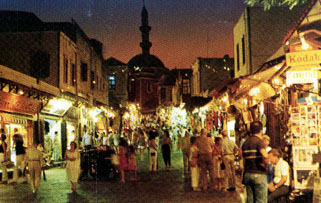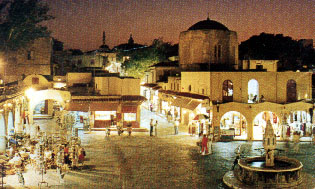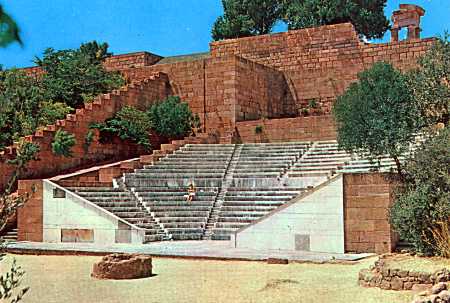|
|
History of the city of Rhodes
 The combination of historical sites belonging to all epochs, 49
picturesque villages and infinitely varied and beautiful
scenery could not be surpassed within such narrow limits.
Exceptional fertility has earned it the name Isle of Roses,
and it matters little if these are the conventional roses or
the rose laurier (oleander), whose pink and white profusion
rivals the deep red of the hibiscus and the heliotrope of the
bougainvillea. According to legend Rhodes was a lovely nymph,
loved by the sun god Helios, who later became identified with
Apollo. Their sons Ialysos, Kamiros and Lindos founded the
three towns named after them, which were united in 408 B.C. to build a new town
on the northeast promontory according to the plans of the
famous architect Hippodamos.
The combination of historical sites belonging to all epochs, 49
picturesque villages and infinitely varied and beautiful
scenery could not be surpassed within such narrow limits.
Exceptional fertility has earned it the name Isle of Roses,
and it matters little if these are the conventional roses or
the rose laurier (oleander), whose pink and white profusion
rivals the deep red of the hibiscus and the heliotrope of the
bougainvillea. According to legend Rhodes was a lovely nymph,
loved by the sun god Helios, who later became identified with
Apollo. Their sons Ialysos, Kamiros and Lindos founded the
three towns named after them, which were united in 408 B.C. to build a new town
on the northeast promontory according to the plans of the
famous architect Hippodamos.
15 km-long walls protected some
100,000 inhabitants in Hellenistic times, wide avenues lined
with 3,000 statues led to five ports, the largest of which was
straddled by the Colossus, one of the Seven Wonders of
Antiquity. From 290-227 B.C. the 31m-high bronze statue of
Helios-Apollo, the master work of Chares of Lindos,
commemorated the successful resistance against King Demetrius
the Poliorcetes (Besieger of Towns). A devastating earthquake
felled Colossus, a Delphic oracle pronounced against its
reerection, and in 654 the Saracen pirates broke up the
enormous figure and shipped the fragments as scrap metal to
Syria. But the Colossus was only the most famous work of the
distinguished Rhodian School of Sculpture characterised by a
tendency towards the colossal.
The main representatives were
Timochares, who carved the bas-relief in the rocks at Lindos,
Philiskos, who executed the group of nine muses transferred to
Rome, Apollonius and Tauriscus, who sculpted the Farnese Bull
now in Naples, while Athenodorus, Agisandrus and Polydorus
collaborated on the deeply moving Laocoon now in the Vatican
Museum. But all were overshadowed by the founder of the
School, Lysippus, the court artist of Alexander the Great,
with his superb Quadriga of the sun god. No less appreciated was the contemporary painter Protogenes
for his symbolical picture of Ialysos. Though rapidly rebuilt
thanks to the contributions of Hellenic sovereigns, creative
art together with political and commercial eminence never
again reached the heights achieved before the terrible
calamity of 227 B.C..
 Instead Rhodes became a major university
town and after incorporation into the Roman Empire attracted
the scions of the noblest families, among them Tiberius
Gracchus, Scipio Africanus, Julius Caesar and Mark Anthony, to
its illustrious Philosophy, Rhetoric and Law Schools. Despite
repeated Saracen invasions Richard Coeur de Lion still
declared himself in 1191 astonished at the splendid remains of
mighty works of art. The Genoese admiral of the Byzantine
fleet, Vignolo de Vignoli, was enfiefed with several islands
for his services to the Empire.
Instead Rhodes became a major university
town and after incorporation into the Roman Empire attracted
the scions of the noblest families, among them Tiberius
Gracchus, Scipio Africanus, Julius Caesar and Mark Anthony, to
its illustrious Philosophy, Rhetoric and Law Schools. Despite
repeated Saracen invasions Richard Coeur de Lion still
declared himself in 1191 astonished at the splendid remains of
mighty works of art. The Genoese admiral of the Byzantine
fleet, Vignolo de Vignoli, was enfiefed with several islands
for his services to the Empire.
In 1306 he sold Rhodes to the
Military Order of Saint John of Jerusalem, temporarily
installed on Cyprus after its expulsion from the Holy Land.
But the Emperor Andronicus II objected and only after four
years of fighting were the Knights allowed to take possession
of the island, eventually extending their dominion over most
of the Dodecanese. The Order, consisting of knights, priests
and serving brothers, was organized into seven national Languages and commanded by a
Grand Master elected for life. Nineteen Grand Masters reigned
in Rhodes, 14 of the French Language . One of them, Pierre d'
Aubussonm repulsed a siege by 70,000 Turks in 1480, a
foretaste of the siege of 1522 by 200,000 men led by the
Sultan Suleiman the Magnificent in person . After a heroic
defense of six months by a mere 600 knights and some 1000
Italian mercenaries, the survivors were granted free passage
to Crete and from there to their new home on Malta. Each
Language was in charge of a section of the 25 m-wide walls .
The three-km circuit of these mighty ramparts still affords
the modern visitor the best view over the narrow lanes with
their graceful arches and supporting buttresses which form
bulwarks against the recurring earthquakes.
Over the flat
roofs rise the cupolas of the Byzantine and the spires of the
Latin churches, as well as the slender minarets of numerous
mosques, the whole framed by lovely gardens across the moat.
The section where the knights once dwelt has been expertly
restored. The splendid Inns of each Language line the Street
of the Knights. The architecture is mainly Gothic, but
modified by Mediterranean adaptations, such as the outside staircases .
Behind the austere facade of the Hospice of the Knights, built
between 1440 and 1489, opens a stately arcaded court from
which the graceful refectory is entered . This is a worthy
setting for the Archaeological Museum, which contains amongst
other finds from all the Dodecanese two outstanding statues of
Aphrodite.
 The Papal Palace of Avignon served Helion de
Veilleneuve (1319-1346) as model for the grandiose Palace of
the Grand Master, reconstructed by the last Italian governor
in 1940 for the Italian royal family or, according to some, as
a retreat for Mussolini. Outstanding within the walled city
are the Castellania, the commercial courts of the Order of
Saint John, the Byzantine Church of Aghios Georgios, the
double-porticoed Mosque of Regib Pasha, the Mosque and Hammam
of Sultan Suleiman. Though much enlarged by addition of a vast
number of excelllent hotels and a casino, the New Town still
bears the imprint of the Italians with their varied
pseudo-styles, which produces a strange conglomeration of
buildings on the waterfront. The New Market is perhaps the
most pleasing, the Church of St. Francis is separated by the
statue of a deer from the pseudo-Venetian Governor's Palace,
Post Office and Bank are in the doubtful style favoured by
Mussolini. The most restful landmark is the small Mosque of
Murad Reis in a Moslem cemetery. Gaily flowered gardens
stretch to the Aquarium, a striking building of rich material,
though severely plain in style, on the island's extreme
northern tip. The large glass tanks contain a varied section
of maritime creatures.
The Papal Palace of Avignon served Helion de
Veilleneuve (1319-1346) as model for the grandiose Palace of
the Grand Master, reconstructed by the last Italian governor
in 1940 for the Italian royal family or, according to some, as
a retreat for Mussolini. Outstanding within the walled city
are the Castellania, the commercial courts of the Order of
Saint John, the Byzantine Church of Aghios Georgios, the
double-porticoed Mosque of Regib Pasha, the Mosque and Hammam
of Sultan Suleiman. Though much enlarged by addition of a vast
number of excelllent hotels and a casino, the New Town still
bears the imprint of the Italians with their varied
pseudo-styles, which produces a strange conglomeration of
buildings on the waterfront. The New Market is perhaps the
most pleasing, the Church of St. Francis is separated by the
statue of a deer from the pseudo-Venetian Governor's Palace,
Post Office and Bank are in the doubtful style favoured by
Mussolini. The most restful landmark is the small Mosque of
Murad Reis in a Moslem cemetery. Gaily flowered gardens
stretch to the Aquarium, a striking building of rich material,
though severely plain in style, on the island's extreme
northern tip. The large glass tanks contain a varied section
of maritime creatures.
|